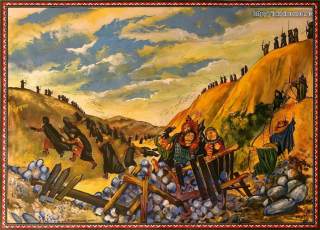I was utterly unprepared for the Scouring in my first read of LotR. Almost every book I had ever read had an ultimate climax, and then a denouement to return the main characters to normalcy. I was shocked that there could be trouble after the Ring is destroyed.

This event was pivotal to my interpretation of the hobbits in my first reading, though. This is where the hobbits display their new-found maturity. The quest has changed each of them, and those changes are displayed throughout their confrontations in the Shire. Merry, Pippin, and Sam all gained courage, confidence, and the ability to lead others.
Nowhere were these traits more apparent to me than in the preparations leading up to the Battle of Bywater. The hobbits of the Fellowship gather together disparate groups of hobbits and rally their spirits to out their oppressors.
For Sam, courage manifests itself on a personal level as he finds the strength to talk to Rosey Cotton, and ultimately marry her. Frodo, though, shows a different type of development. He has learned pity and mercy after these characteristics saved his life and all of Middle-earth. He demonstrates this several times in his interaction with Saruman and Wormtongue outside of Bag End. He offers them freedom and forgiveness several times.
As a child, I detected the changes in Pippin and Merry much more readily than those in Frodo and Sam. Their actions and outward appearance changes drastically after the quest. Even Sam was easier to understand because he seeks out more responsibility and involvement in the community. While Frodo partakes in many of these same responsibilities, this is not as noticeable a change for him.
Unlike the other hobbits, though, Frodo carries wounds that never heal. While Frodo was my least favorite hobbit, I still pitied his pain and I wondered if he would ever find healing.
Where Do We Go From Here?
To the Grey Havens, then on to the final words of the story.
What Do You Think?
How did you react to the change in the hobbits?
What did you think of Frodo’s pain?
Did I miss anything? Let me know!












 One of the most significant aspects of my first exposure to the work was that I saw each of the hobbits as undergoing a process of maturing. This lens highlighted the fact that Frodo was just “coming of age” in the reckoning of the shire-folk (as a youth, I often equated this age with becoming a teenager).
One of the most significant aspects of my first exposure to the work was that I saw each of the hobbits as undergoing a process of maturing. This lens highlighted the fact that Frodo was just “coming of age” in the reckoning of the shire-folk (as a youth, I often equated this age with becoming a teenager).